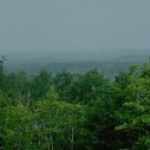
Last week several environmental groups asked federal agencies and the state of Minnesota to take a more active role in preventing air pollution that contributes to haze over Voyageurs and Isle Royale National Parks and the Boundary Waters Canoe Area Wilderness.
The National Park Conservation Association, the Minnesota Center for Environmental Advocacy, Voyageurs National Park Association and the Friends of the Boundary Waters Wilderness asked the Minnesota Pollution Control Agency to revise the state’s haze reduction state implementation plan (SIP) to include more stringent pollution controls on power plants and other pollution sources. They also asked the U.S. Department of Interior and the Department of Agriculture to formally urge Minnesota to address pollution admissions from Xcel Energy’s Sherburn Country Generating Plant (Sherco) in Becker, Minnesota.
Citing visible emissions from Sherco and Xcel Energy air models demonstrating the plant’s contribution to haze over the national parks and the wilderness, the groups suggested that better controls on pollution are necessary to protect the air quality in these areas. Identified as Class I airsheds, the Clean Air Act stipulates that they should have the cleanest air in the country and states should improve and protect their air quality.
“The beautiful coastal scenery in Isle Royale and Voyageurs National Parks should not have to be viewed through a haze,” said Lynn McClure, regional director of NPCA’s Midwest office. “This is Minnesota’s long-awaited opportunity to improve air quality for its citizens and the visitors to the region’s national parks and wilderness areas.”
The public comment period for the SIP ended September 3. According to Catherine Neuschler of the MPCA, comments are still under review. The agency will prepare formal responses by making changes to the SIP or providing further explanation. Because the plan has been controversial, the SIP and the responses will be reviewed with the MPCA’s citizen’s board prior to submission to the U.S. EPA for approval. Neuschler anticipates that this meeting, which will be open to the public, will take place in the next couple of months. At that time, the board can approve the SIP or require further changes.
Because this is federal process, the public will have one more opportunity to weigh in. The EPA will review the plan and publish its ruling (approval, disapproval, or a conditional approval) in the federal registry, at which point it will be available for public comment once more. Neuschler is hopeful that EPA approval will be secured by the end of 2011.
Formal concerns raised by the environmental groups during the comment period will be addressed as part of the current review process. Because the formal petition regarding Sherco were submitted to other agencies, it was too early for Neuschler to comment on how that might play a role in the formal approval of the SIP.

